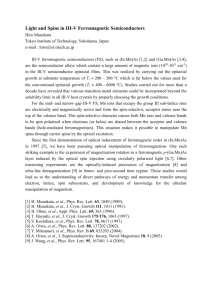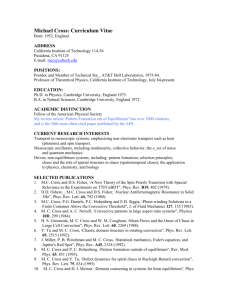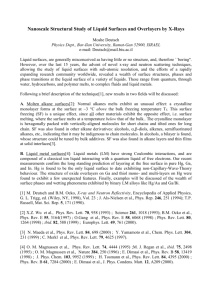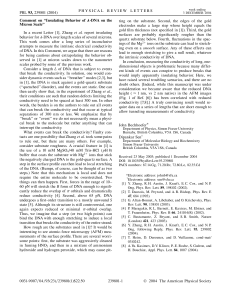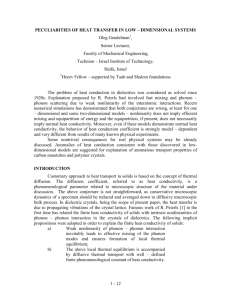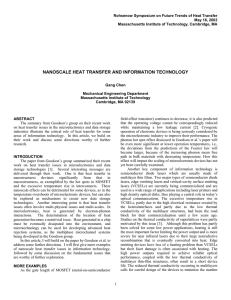Improving the Conduction Properties of DNA
advertisement
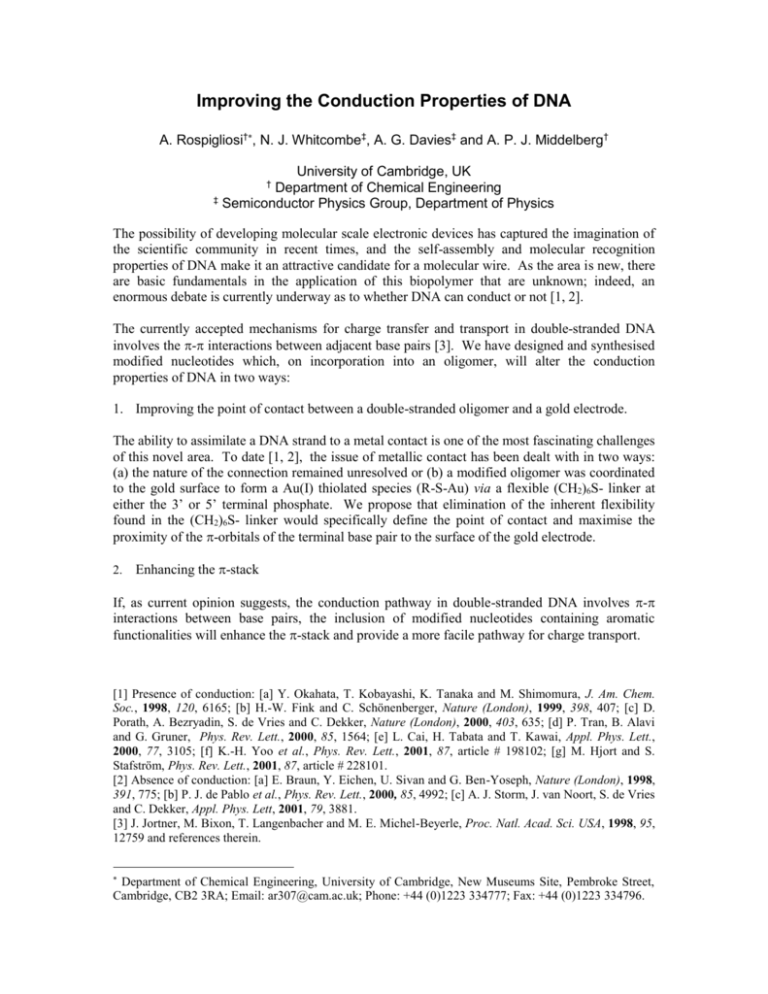
Improving the Conduction Properties of DNA A. Rospigliosi†, N. J. Whitcombe‡, A. G. Davies‡ and A. P. J. Middelberg† University of Cambridge, UK Department of Chemical Engineering ‡ Semiconductor Physics Group, Department of Physics † The possibility of developing molecular scale electronic devices has captured the imagination of the scientific community in recent times, and the self-assembly and molecular recognition properties of DNA make it an attractive candidate for a molecular wire. As the area is new, there are basic fundamentals in the application of this biopolymer that are unknown; indeed, an enormous debate is currently underway as to whether DNA can conduct or not [1, 2]. The currently accepted mechanisms for charge transfer and transport in double-stranded DNA involves the - interactions between adjacent base pairs [3]. We have designed and synthesised modified nucleotides which, on incorporation into an oligomer, will alter the conduction properties of DNA in two ways: 1. Improving the point of contact between a double-stranded oligomer and a gold electrode. The ability to assimilate a DNA strand to a metal contact is one of the most fascinating challenges of this novel area. To date [1, 2], the issue of metallic contact has been dealt with in two ways: (a) the nature of the connection remained unresolved or (b) a modified oligomer was coordinated to the gold surface to form a Au(I) thiolated species (R-S-Au) via a flexible (CH2)6S- linker at either the 3’ or 5’ terminal phosphate. We propose that elimination of the inherent flexibility found in the (CH2)6S- linker would specifically define the point of contact and maximise the proximity of the -orbitals of the terminal base pair to the surface of the gold electrode. 2. Enhancing the -stack If, as current opinion suggests, the conduction pathway in double-stranded DNA involves - interactions between base pairs, the inclusion of modified nucleotides containing aromatic functionalities will enhance the -stack and provide a more facile pathway for charge transport. [1] Presence of conduction: [a] Y. Okahata, T. Kobayashi, K. Tanaka and M. Shimomura, J. Am. Chem. Soc., 1998, 120, 6165; [b] H.-W. Fink and C. Schönenberger, Nature (London), 1999, 398, 407; [c] D. Porath, A. Bezryadin, S. de Vries and C. Dekker, Nature (London), 2000, 403, 635; [d] P. Tran, B. Alavi and G. Gruner, Phys. Rev. Lett., 2000, 85, 1564; [e] L. Cai, H. Tabata and T. Kawai, Appl. Phys. Lett., 2000, 77, 3105; [f] K.-H. Yoo et al., Phys. Rev. Lett., 2001, 87, article # 198102; [g] M. Hjort and S. Stafström, Phys. Rev. Lett., 2001, 87, article # 228101. [2] Absence of conduction: [a] E. Braun, Y. Eichen, U. Sivan and G. Ben-Yoseph, Nature (London), 1998, 391, 775; [b] P. J. de Pablo et al., Phys. Rev. Lett., 2000, 85, 4992; [c] A. J. Storm, J. van Noort, S. de Vries and C. Dekker, Appl. Phys. Lett, 2001, 79, 3881. [3] J. Jortner, M. Bixon, T. Langenbacher and M. E. Michel-Beyerle, Proc. Natl. Acad. Sci. USA, 1998, 95, 12759 and references therein. Department of Chemical Engineering, University of Cambridge, New Museums Site, Pembroke Street, Cambridge, CB2 3RA; Email: ar307@cam.ac.uk; Phone: +44 (0)1223 334777; Fax: +44 (0)1223 334796.

![[1]. In a second set of experiments we made use of an](http://s3.studylib.net/store/data/006848904_1-d28947f67e826ba748445eb0aaff5818-300x300.png)
